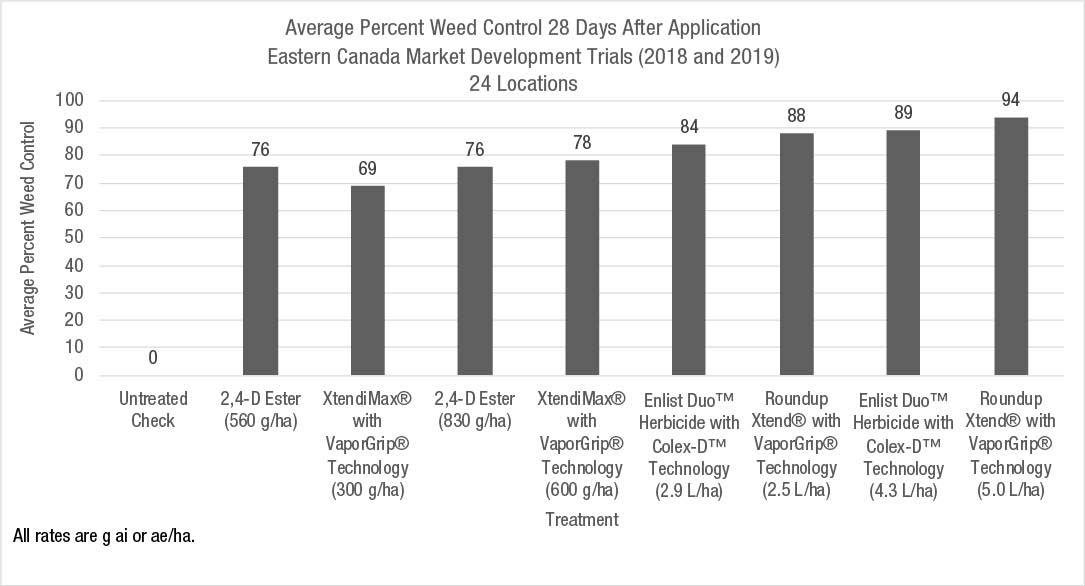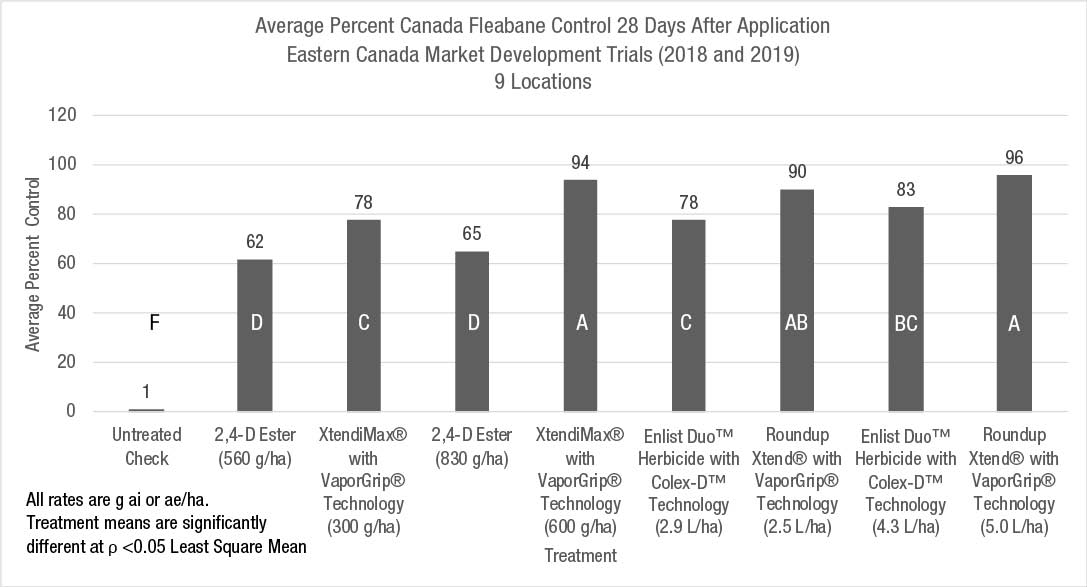Head-to-head: A weed control comparison of the Roundup Ready Xtend Crop System vs. Enlist weed control system
Feb 04, 2022
Herbicide tolerance traits are an important production tool for soybean growers across Canada who are looking for high yielding, high quality crops. The two primary systems they can choose from are the Roundup Ready® Xtend Crop System, which includes soybean varieties tolerant to dicamba, and the Enlist™ weed control system, which includes varieties tolerant to 2,4-D choline.
Both systems include varieties with traits that confer tolerance to glyphosate and/or glufosinate. In the case of the Roundup Ready Xtend Crop System, for example, growers can choose between Roundup Ready 2 Xtend® soybeans with tolerance to dicamba and glyphosate, or XtendFlex® soybeans, which offer tolerance to dicamba, glyphosate and glufosinate.
In order to compare the weed control efficacy of each system, Bayer conducted replicated small plot trials across Canada in 2018 and 2019. The trials were designed to be head-to-head comparisons of how well and how long certain broadleaf weeds are controlled by the herbicides recommended for each system.
Researchers also looked at short-term residual control of dicamba versus 2,4-D for small-seeded broadleaf weeds, as well as their efficacy on some specific annual broadleaf weeds, including the glyphosate-resistant kochia in Western Canada and glyphosate-resistant Canada fleabane in Eastern Canada.
How it was done
In the first year of the project, replicated plot trials were conducted in 11 locations in Eastern Canada and seven in the West. The next year (2019) there were 13 eastern locations and eight in the West for a total of 39 trial locations across two years.
Each trial location consisted of nine treatments, with three replications, in a complete block design. Those treatments were:
- untreated check
- 2,4-D Ester at 560 g/ha
- XtendiMax® with VaporGrip® Technology at 600 g/ha
- 2,4-D Ester at 830 g/ha
- XtendiMax with VaporGrip Technology at 600 g/ha
- Enlist Duo™ with Colex-D™ technology at 2.9 L/ha
- Roundup Xtend® with VaporGrip Technology at 2.5 L/ha
- Enlist Duo™ with Colex-D™ Technology at 4.3 L/ha
- Roundup Xtend with VaporGrip Technology at 5 L/ha
Weed control ratings at all locations were taken at 12, 21, 28 and 56 days after application (DAA).
The results
Overall, the trial results showed that dicamba offers better short-term residual control of small-seeded broadleaf weeds, along with greater efficacy on some specific annual broadleaf weeds, including glyphosate-resistant kochia in Western Canada, and glyphosate-resistant Canada fleabane in Eastern Canada, with some rate-to-rate exceptions (see Figures below).
More specifically, researchers looked at results on a national and regional basis. They measured the average percent of residual weed control at the four designated periods after application, plus they looked at how the herbicides controlled specific weeds. Here's what they found.
National results
At the 39 trial locations across Canada, there was a total of 110 broadleaf weed hits with the predominant species being:
- Lamb's quarters (23)
- Redroot pigweed (18)
- Kochia (99)
- Canada fleabane (9)
28 DAA. Across the 39 trial locations, the average percent of residual weed control for Roundup Xtend at a rate of 5 L/ha was significantly better for general broadleaf weed control compared to Enlist Duo™ with Colex-D™ Technology at a rate of 4.3 L/ha (figure 1).
 Fig 1: Average percent weed control 28 DAA at 39 locations across Canada in 2018 and 2019.
Fig 1: Average percent weed control 28 DAA at 39 locations across Canada in 2018 and 2019.
56 DAA. There was a similar result 56 DAA where the gap widens between Roundup Xtend at 5 L/ha and Enlist Duo™ with Colex-D™ Technology at 4.3 L/ha in terms of average percent of residual broadleaf weed control (figure 2).
Lower rates. Still at 56 DAA, the average percent of residual broadleaf weed control for Roundup Xtend at 2.5 L/ha was significantly better than Enlist Duo™ with Colex-D™ Technology at 2.9 L/ha (figure 2).
 Fig 2: Average percent weed control 56 DAA at 39 locations across Canada in 2018 and 2019.
Fig 2: Average percent weed control 56 DAA at 39 locations across Canada in 2018 and 2019.
Eastern Canada results
At the 24 trial locations in Eastern Canada, there was a total of 73 broadleaf weed hits with the predominant species being:
- Lamb's quarters (16)
- Redroot pigweed (10)
- Canada fleabane (9)
28 DAA. Across the 24 trial locations, researchers found that Roundup Xtend at 5 L/ha gave 94% general broadleaf weed control compared to 89% general control with Enlist Duo™ with Colex-D™ Technology at 4.3 L/ha (figure 3).
 Fig 3: Average percent weed control 28 DAA at 24 locations across Eastern Canada in 2018 and 2019.
Fig 3: Average percent weed control 28 DAA at 24 locations across Eastern Canada in 2018 and 2019.
Western Canada results
At the 15 trial locations across Western Canada, there was a total of 37 broadleaf weed hits. The predominant species were:
- Lamb's quarters (7)
- Redroot pigweed (8)
- Kochia (9)
28 DAA. The average percent of residual weed control for Roundup Xtend at a rate of 5 L/ha was 93% for general broadleaf weed control compared to 83% for Enlist Duo™ with Colex-D™ Technology at a rate of 4.3 L/ha. (Figure 4)
Lower rates. Also at 28 DAA, dicamba showed greater weed control than 2,4-D choline when both were applied at lower rates. Roundup Xtend at 2.5 L/ha provided 81% general broadleaf weed control, while Enlist Duo™ with Colex-D™ Technology at 2.9 L/ha provided 74% control (figure 4).
 Fig 4: Average percent weed control 28 DAA at 15 locations across Western Canada in 2018 and 2019.
Fig 4: Average percent weed control 28 DAA at 15 locations across Western Canada in 2018 and 2019.
Kochia and Canada fleabane results
Kochia control. At nine of the 15 trial locations in Western Canada, Roundup Xtend consistently outperformed Enlist Duo™ with Colex-D™ Technology in terms of residual kochia control 28 DAA. Similarly, XtendiMax, a stand-alone dicamba product, offered a significantly better residual kochia control than 2,4-D Ester (figures 5 and 6).
 Fig 5: Average percent kochia control 28 DAA at nine locations across Western Canada in 2018 and 2019.
Fig 5: Average percent kochia control 28 DAA at nine locations across Western Canada in 2018 and 2019.
 Fig 6: Comparison of residual kochia control, Carseland, Alberta, July 2018.
Fig 6: Comparison of residual kochia control, Carseland, Alberta, July 2018.
Canada fleabane. At nine of the 24 trial locations in Eastern Canada, the average percent of residual Canada fleabane control, 28 DAA, was significantly better with Roundup Xtend at 5 L/ha compared to Enlist Duo™ with Colex-D™ Technology at 4.3 L/ha, and with XtendiMax compared to the 2,4-D Ester (figures 7 and 8).
 Fig 7: Average percent Canada fleabane control 28 DAA at nine locations across Eastern Canada in 2018 and 2019.
Fig 7: Average percent Canada fleabane control 28 DAA at nine locations across Eastern Canada in 2018 and 2019.
 Fig 8: Comparison of residual Canada fleabane control, Thamesville, Ontario, 2019.
Fig 8: Comparison of residual Canada fleabane control, Thamesville, Ontario, 2019.
Key Takeaways
This trial demonstrated that the broadleaf weed control of Roundup Xtend with VaporGrip Technology was significantly better than the broadleaf weed control of Enlist™ Duo with Colex-D™ Technology.
The trial results also showed that dicamba provides better overall broadleaf weed control and short-term residual weed control than 2,4-D Ester.
Researchers found that applying dicamba alone in the Roundup Ready Xtend Crop System is not recommended and that a Roundup® brand tank mix partner should always be included with XtendiMax herbicide with VaporGrip Technology.